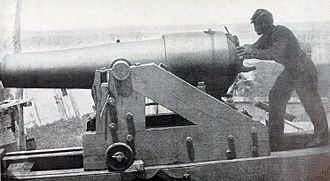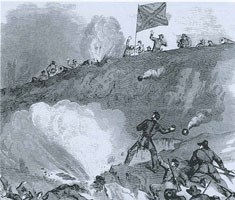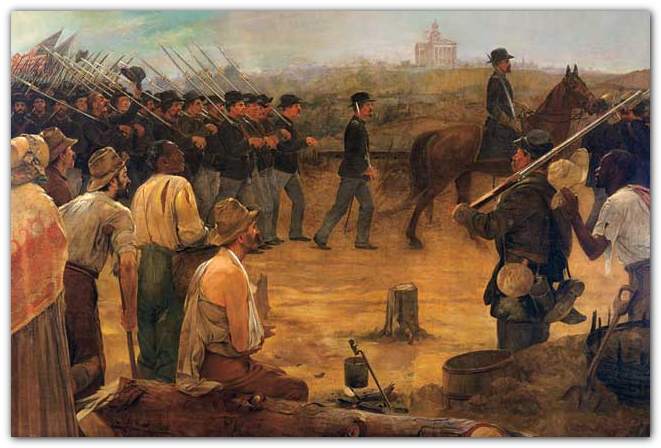
The Vicksburg Campaign
A strategic spot blocking Union navigation on the Mississippi River (Confederate President Jeffereson Davis will call the city "... the nail that holds the South's two halves together" ... and Union President Abraham Lincoln will state, "Vicksburg is the key. The war can never be brought to a close until that key is in our pocket.") called "The Gibralter of the Confederacy," in the fall of 1862, the newly appointed commander of all Union armies, Major General Henry W. Halleck, orders Grant to take the town. Orders for the 77,000 strong Army of the Tennessee that are fraught with challenge, Grant and his men march south and begin a crucial campaign that will be one of the turning points in the American Civil War. Opposing Grant and his men are the 40,000 men of the Army of Mississippi commanded by former Union officer, Pennsylvania born Lt. General John Clifford Pemberton.

Grant

Pemberton
Initially planned as a two-prong attack on the fortress town with Major General William Tecumseh Sherman advancing along the Yazoo River from the northeast (they will be stopped by the Confederate defenses at Chickasaw Bayou) while Grant marches on Vicksburg from the line of the Mississippi Central Railroad (to the forward base of Holly Springs, a base that will be destroyed by the cavalry of Brigadier General Nathan Bedford Forrest), the plan is redesigned once both forces fail to meet their goals. In their place, Grant will try a number of military "experiments" that also fail to come to grip with the town ... there is an attempt to build a canal across the region's De Soto Peninsula, another canal attempts to link the Mississippi to Lake Providence, after blowing up a levee near Moon Lake (150 miles above Vicksburg) the Yazoo Pass expedition is launched (low hanging trees will block the way), another expedition fails due to trees at Steele's Bayou, and another canal is tried between Duckport Landing and Walnut Bayou. Months of failure, success is finally achieved when Grant marches his command down the west side of the Mississippi River, moves south of Vicksburg, and then crosses back over to the Vicksburg side of the river on the troop transports and gunboats of Rear Admiral David Dixon Porter's Mississippi River Squadron (on 4/16/1863, a clear night with no moon, seven gunboats and three empty troop transports get by the guns of Vicksburg with the disabling of only one vessel, the Henry Clay, and the wounding of thirteen men, a success matched by six more boats filled with supplies on 4/22) in the largest amphibious operation in American military history (until being topped by the 6/6 D-Day in Normandy during WWII). Army and Navy in cooperation, with Confederate forces confused by a Sherman feint against Snyder's Bluff and a cavalry raid through central Mississippi by Colonel Benjamin Grierson, on 4/29/1863, Grant and Porter are able to move 17,000 soldiers from Disharoon's Plantation across the river to Bruinsburg, Mississippi.
Sherman
Forrest
Porter
Grierson

Gunboat Run
Moving inland, Grant makes the decision not to link up with the soldiers of Major General Nathaniel P. Banks in New Orleans (Grant will be under Banks' more senior command should the two forces combine) and begins a series of maneuvers that force Pemberton's troops back into Vicksburg. Trying to stop the juggernaut moving towards the fortress town, there will be battles against the Mississippi Confederates at Port Gibson (5/1), the town of Raymond (5/12), the Mississippi state capital of Jackson (5/14, after General Joseph E. Johnston command flees the city), Champion Hill (5/16), and Big Black River Bridge (5/17). Trapping Pemberton's forces inside Vicksburg (he is ordered to save his command and fight his way to Johnston's men near Jackson but waits too long to even make the attempt), after two frontal assaults that take place on 5/19 (157 men killed and another 777 wounded) and 5/22 (502 men killed and another 2,550 wounded) fail to break the strong Confederate defenses (a 6.5 mile long line of gun pits, lunettes, forts, redoubts, and trenches on hills and steep knobs manned by 18,500 soldiers), Grant begins siege operations against the city.
Assault

Vicksburg Confederate 18-Pounder
Assault
Siege ... on 5/25 Grant makes it official with orders that read, "Corps Commanders will immediately commence the work of reducing the enemy by regular approaches. It is desirable that no more loss of life shall be sustained in the reduction of Vicksburg, and the capture of the Garrison. Every advantage will be taken of the natural inequalities of the ground to gain positions from which to start mines, trenches, and advance batteries" ... Union gunboats on the water (they will lob over 22,000 shells into the city before the siege ends) and Grant's men on land (who will send even more shells into the city, a bombardment that causes the citizens to start digging into Vicksburg's yellow, clay hills ... eventually taking a degree of shelter in over 500 caves that earn the town a new name, "Prairie Dog Village" ... and to a degree it works, only 12 citizens will be killed in the town's bombardment), Pemberton decides to hold out as long as he can, but encirclement completed (with reinforcements sent south by Halleck, Grant will have roughly 77,000 men under his command in the Vicksburg region, some inching Union positions forward and others preventing Pemberton from receiving help from Johnston), the city's days as a Confederate bastion are numbered. Plenty of ammo but little in the way of food, the city's residents and soldiers are soon suffering from scurvy, diarrhea, dysentery, malaria, other diseases, and starvation to the point where horses, mules, cats, and dogs vanish into dinner pots and some begin eating boiled shoe leather.

Union Artillery
Then

Now
A daily grind for both sides as May gives way to June and then July approaches, the only events that break up the monotony of inching into Vicksburg are the explosions the Union sets off at a strongpoint called the 3rd Louisiana Redan. There, on 6/25/1863, 2,200 pounds of dynamite is exploded, forming a crater 40 feet in diameter and 12 feet deep that the 45th Illinois Regiment of Colonel Jasper A. Maltby charge into ... but not through as Confederate rifles once more stop the Union advance. Crater widened for another attack, before another explosion/assault cycle takes place, Pemberton asks for terms of surrender on 7/3 (unconditional surrender that Grant has made a reputation on is not requested as the Union officer does not want to have to guard and feed 30,000 soldiers and citizens), and the issue of soldier paroles resolved, surrenders his command to Grant (and becomes one of the most hated men in the South) on the 4th of July (rumors will soon have the town not celebrating the Indepence Day holiday again until 1945), along with 172 cannons and 50,000 rifles. Over, a major supply artery for the Confederacy becomes a Union possession, cutting off Louisiana, Texas, and Arkansas from the other rebel states. As Lincoln will say, "The Father of Waters again goes unvexed to the sea." But not without a price ... in the campaign for Vicksburg and its siege, the Union will suffer 10,142 casualties, while along with losing the strategic position on the river, the Confederates will take losses of 9,091 soldiers.

Fighting At The Crater
Sniping

Surrender
5/18/1863 ... the siege of Vicksburg begins (portions of the battlefield are now preserved by the National Park Service at the Vicksburg National Military Park that includes 1,325 historic monuments and markers, 20 miles of trenches and earthworks, a 16 mile tour road, a 12.5 mile walking trail, two antebellum homes, 144 cannons, the restored Union gunboat, USS Cairo, sunk 12/12/1862 on the Yazoo River during the campaign)., and the failed experiment of Grant's Canal.
Victory

Grant Monument At Vicksburg
;, .
Victory
XXXXXXXXXXXXXXXXXXXXXXXXXXXXXXXX
No comments:
Post a Comment